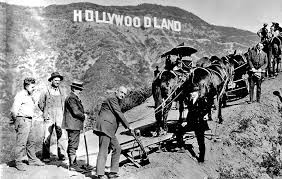The Hollywood Sign Viewpoint
Introduction
Text-to-speech Audio
The Hollywood Sign was built in 1923 as a promotional campaign for a new suburban housing development called "Hollywoodland." In the decades that followed, it became a global symbol of the entertainment industry and the city of Los Angeles. Perhaps ironically, real estate was the most profitable sector of the Los Angeles economy, although the area's connection to the film industry has also contributed to its success.
Images
Men trudging up the outrageously steep Mount Lee to visit the real estate billboard

The deterioration of the Hollywood Sign

The Hollywood Sign today

Backstory and Context
Text-to-speech Audio
Before the phenomenon of the Hollywood entertainment industry, the site at Mt. Lee, which now overlooks Rodeo Drive and the Boulevard known to the world, resembled any other Western frontier landscape, with cowboys, prospectors, bandits, and mostly undeveloped land. Any real estate north of Sunset Boulevard was considered useless for anything but grazing. Easterners were drawn to Southern California by the sunny skies and mild weather. It wasn’t long before the “useless” land started sprouting subdivisions, and by the end of the 19th century, Hollywood was transforming itself into a real town. Its name originated in 1887 when Daeida Wilcox heard a young woman refer to her Florida summer home, “Hollywood.” The name seemed so fitting, she suggested it to her husband, and that was the birth of Hollywood.
Due to the favorable weather, which allowed for year-round outdoor filming, the film industry began to expand in this area. Nestor Film Company, the first real studio, soon followed. The company cranked out three pictures of different genres for a total of $1,200. By 1912, word began to spread of this ideal shooting climate and landscape in Hollywood. Fifteen independent studios were soon shooting around town, and barns were quickly converted into sound stages. The once-silent Western frontier was full of the yells of directors and actresses demanding makeup. By 1915, LA had grown significantly, and during the Roaring Twenties, a whimsical skyline of movie-set-inspired hotels and apartments emerged along the big boulevards. Stars began to buy prestigious real estate. This aristocratic society became the extravagant Hollywood glitterati, where excess was the entry fee to fame.
Hollywood was no longer “just a city.” It was an industry, a lifestyle, and an aspiration. In 1923, it was officially crowned when the “Hollywoodland” sign was built. Los Angeles Times publisher Harry Chandler was the grand architect of the sign. His intention was to build a glamorous sign for his upscale Hollywoodland real estate development. This sign soon took the role of a giant marquee for a city that was always announcing its own gala premiere. Massive in size, each of the original 13 letters was 300 feet wide and approximately 43 feet tall. They were constructed of 3x9’ metal squares rigged together by an intricate frame of scaffolding pipes, wires, and telephone poles. The materials were to be dragged up the steep, intimidating Mt. Lee dirt roads. When it was completed, the sign twinkled and blinked first “Holly,” then “wood,” and finally “land.” Initially, it was only supposed to last a year, but the sign has been around for more than eight decades and still sparkles.
Just as the entertainment industry had become stable and prosperous, tragedy hit in 1941 with the Pearl Harbor Attack. Hollywood became a full-time war industry. Studio trucks transported troops instead of movie sets. Stars began to enlist, and patriotic fare dominated the silver screens. The war brought people together. Hollywood began to pull together to feed, shelter, and entertain the soldiers. The Hollywoodland real estate development went bankrupt, a consequence of the Depression, in the early 1940s. The sign hadn’t been maintained in years and quietly became property of the city in 1944. The sign had made an essential transition from billboard to de facto civic landmark. The war slowed the march of the Hollywood entertainment industry, and the aging icon showed signs of neglect. The Hollywood Chamber of Commerce finally came to the rescue of the sickly sign, removing the letters that spelled “Land” and repairing the rest, including the recently toppled “H.” The sign was reintroduced as a leaner, cleaner sign in its now iconic form. In 1973, the Los Angeles Cultural Heritage Board designated the sign as an official landmark. However, with the growth of the city, the sign had deteriorated somewhat.
The Hollywood Chamber of Commerce (HCC) determined that the sign needed yet another complete renovation. Though restoration was expensive, the biggest names in film came together, raising enough money. As Hollywood blossomed, so did the sign. Government officials in Los Angeles, along with the HCC and the Hollywood Sign Trust, have come together to enact permanent preservation measures, including 24/7 monitoring. What is now the symbol of the entertainment industry was created initially as an outdoor campaign for a suburban housing development called “Hollywoodland.” Despite the high profile of the film and TV business, real estate has always been Hollywood’s chief economic determinant.
Cite This Entry
M., Ben and Clio Admin. "The Hollywood Sign Viewpoint." Clio: Your Guide to History. July 18, 2025. Accessed August 11, 2025. https://theclio.com/entry/23926
Sources
"The History of the Sign." Hollywood Sign. Accessed April 11, 2011. http://hollywoodsign.org/the-sign-today.

